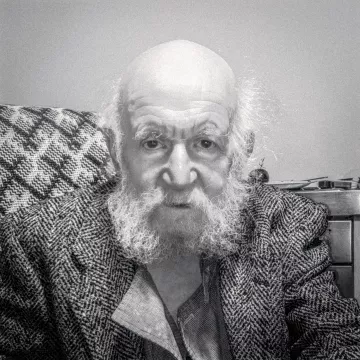Auto-destructive art – a public art form – sought to provide a mirror of a social and political system that Metzger felt was progressing towards total obliteration. At the heart of his practice, which spanned over 70 years, are a series of constantly opposing yet interdependent forces such as destruction and creation. He has had solo exhibitions around the world, including Hauser & Wirth, Somerset, UK (2021); Circuit, Lausanne (2018); West, Den Haag (2018); MAMAC, Nice (2017); MUSAC, León (2016); Tate Britain, London (2016); Museo Jumex, Mexico City (2015); CoCA Torun, Poland (2015); Neuer Berliner Kunstverein, Berlin (2015); Kunsthall Oslo and Kunstnernes Hus, Oslo (2015); Tel Aviv Museum of Art (2014); Kettle’s Yard, Cambridge (2014); New Museum, New York (2011) and Serpentine Galleries, London (2009).

Hans Ulrich Obrist Archives – Chapter 4: Gustav Metzger – All of Us Together
© Victor&Simon - Renata Pires
Hans Ulrich Obrist Archives – Chapter 4: Gustav Metzger – All of Us Together
The Tower
Underground, Level - 3
Cherry Tree Gallery, Level-2
From
to
For its fourth chapter, the Hans Ulrich Obrist Archives at LUMA Arles presents an exploration of the work of Gustav Metzger (born 10 April 1926 in Nuremberg, passed away on 1 March 2017 in London), an essential figure for ecology and activism in the arts.
Drawing upon a two-decade-long friendship between Metzger and Obrist, the exhibition unfolds over two levels, providing both an immersion into never-before-seen archives and a panorama of the artist’s most iconic works, the pertinence of which is ever more urgent.
During their first studio visit in 1991 in Glasgow, Douglas Gordon drew Hans Ulrich Obrist’s attention to the works of Gustav Metzger and John Latham, both pioneers and indispensable inspirations for a then-emerging generation of artists in the United Kingdom. After consulting Norman Rosenthal’s catalogue of Art Into Society - Society Into Art (1974), which featured his contribution, a statement calling for Years without Art (1977-1980), Obrist attempted to reach Metzger by all available means.
He would find himself waiting until Metzger, one day, came to the Serpentine Gallery to see him and Julia Peyton Jones during the first iteration of the exhibition Take me (I’m Yours) in 1995. After Metzger’s Historic Photographs were featured in Damaged Nature: Two New Works and Documents in 1995 at the independent space workfortheeyetodo in London; Suzanne Pagé, Laurence Bossé, and Hans Ulrich Obrist added these works to life/live: la scène artistique au Royaume-Uni en 1996, de nouvelles aventures [life/live: the artistic scene in the United Kingdom in 1996, new adventures, 1996], at the ARC - Musée d’Art Moderne de la Ville de Paris.
Their first recorded conversation took place in 1997 at the legendary Café Cosmo, a sanctuary for political exiles during the conflicts of the 20th century in London. Their dialogue continuously unveiled Metzger’s commitment and activist principles. In 1999, Barbara Vanderlinden and Obrist involved him in the project inspired by Bruno Latour, Laboratorium, integrating scientists and artists at the Provinciaal Fotografie Museum in Antwerp. There, Metzger reactivated the work Drop on Hotplate (1968/2024), a basic everyday hotplate elevated to chest height on a metal base, onto which a drop of water is slowly released, causing a spontaneous and random reaction in response to the heat.
Their bond intensified when Hans Ulrich Obrist settled in London. Metzger was a key participant in the Serpentine’s first marathon, the Interview Marathon (2006), conceived with Rem Koolhaas. Cultivating mystery, Metzger used red telephone boxes as his means of communication. Consequently, the Serpentine somewhat became his post office box during his retrospective Decades: 1959-2009 in 2009. He later co-curated there the Extinction Marathon: Visions for the Future in 2014.
The sentence ‘All of us together,’ the title of this exhibition, was composed in 2014 for Hans Ulrich Obrist’s Handwriting Project. It is part of a collection of notes titled Extinction Handwritings by Metzger. The exhibition compiles the questions Metzger provoked during his life and career, manifested in the presentation of archival material through around ten hours of interviews, handwritten and printed documents, alongside personal notes and other ephemera. The archival presentation complements an in-depth exhibition that brings together works such as Liquid Crystal Environment (1965/2024) and Mass Media: Today and Yesterday (1971/2024). Posters created in tribute to Metzger highlight the significance of his work and its importance in confronting the crises of today and tomorrow. This exhibition, posthumously, is a way to convey the inspiration Metzger felt for Luc Hoffmann’s way of protecting the climate and the bioregion of the Camargue. He always dreamed of meeting the co-founder and first president of the World Wildlife Fund (WWF) and founder of the Tour du Valat research centre in the Camargue. Like Luc Hoffmann (1923-2016), Gustav Metzger will also remain, through his works and his thoughts, a cornerstone of the ecological movements of the 20th and 21st centuries.
Curated by Hans Ulrich Obrist, Senior Advisor and Arthur Fouray, Archivist and Curator.
Gustav Metzger
Gustav Metzger was born in Nuremberg, Germany, on 10th April 1926 to Polish-Jewish parents and arrived in Britain on the Kindertransport in 1939.
Much of his immediate family perished in the Holocaust. From 1945-53, he studied art in Cambridge, London, Antwerp, and Oxford – for much of this time associated with the artist David Bomberg. By 1958, Metzger was becoming heavily involved in anti-capitalist, anti-consumerist movements, and the Campaign for Nuclear Disarmament. In 1960 he was a founder member of the Committee of 100 and this led to a short imprisonment in 1961 with Bertrand Russell and other members of the Committee for encouraging mass non-violent civil disobedience. Metzger’s political activism provided the foundation for his first artist manifesto in 1959, titled ‘Auto-destructive Art’, which he described ‘as a desperate last-minute subversive political weapon… an attack on the capitalist system… (an attack also on art dealers and collectors who manipulate modern art for profit).’
